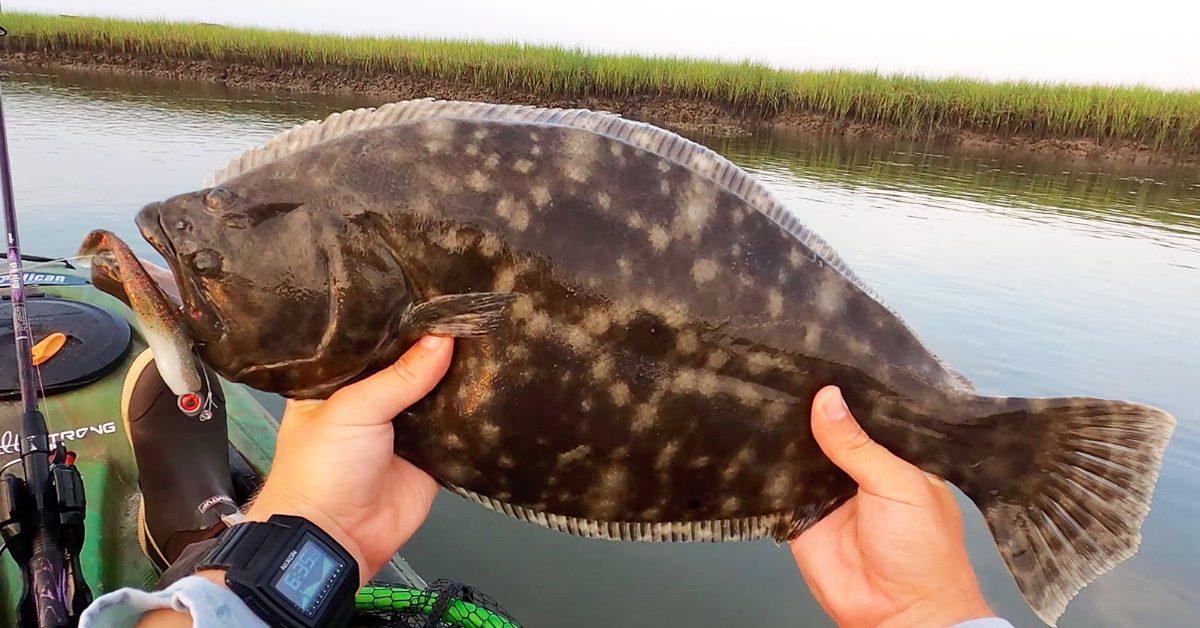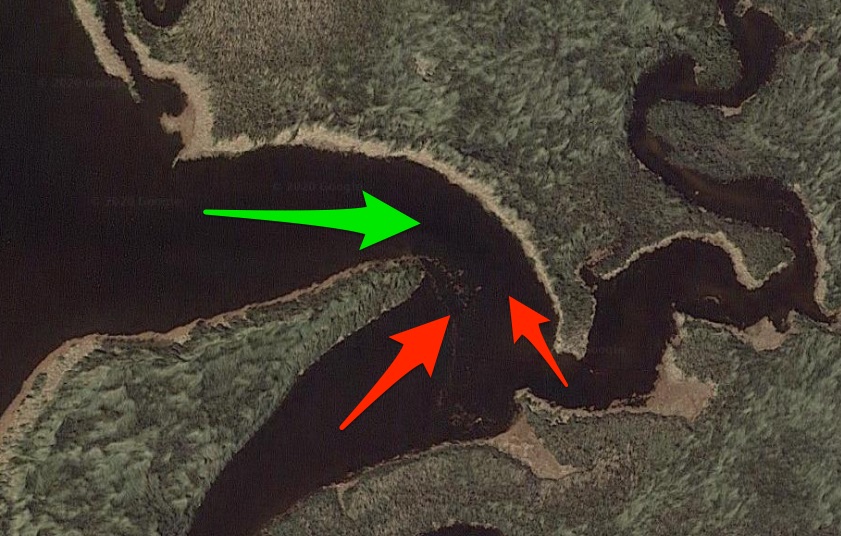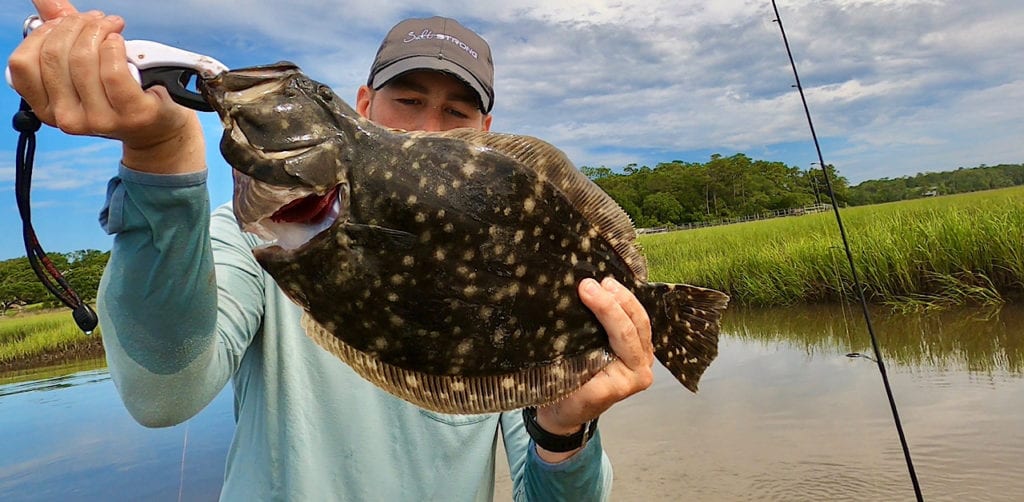Where & When To Catch Inshore Flounder (No Matter Where You Live)
- By: Wyatt Parcel
- on
- Found In: Fishing Tips, Inshore Fishing, Flounder, Weekly Newsletter: 7-5-20

Have you heard of the 90-10 rule?
It states that 90% of the fish are going to be in 10% of the water.
It’s true for all fish, but especially flounder.
If you’re using an attractive search bait, like a paddletail or topwater lure, a redfish or trout might come chase it down when they hear or feel the commotion.
However, flounder plant themselves on the bottom waiting for an easy meal to swim by, so unless you put your lure right in front of their face, there’s essentially zero chance of you catching one.
To catch them, you need to be very intentional about where to find them.
So where do flounder like to hang out?
Check out the video below.
P.S. Using these tips, I was able to land my personal-best flounder, and then beat it the very next week!
The Best Place & Time To Catch Flounder [VIDEO]

Since a flounder is a flounder, no matter if it’s from Texas or North Carolina, these tips will work wherever you live.
To know where to find them, you first need to understand what and how they eat.
What & How Flounder Eat
In the spring, flounder come from their offshore winter homes to their summer inshore homes.
This is because in the springtime there’s an influx of baitfish and shrimp that show up in the marshes, creeks, and bays and these flounder are looking for easy meals.
And although all of the inshore gamefish are ambush predators, flounder take it to the next level.
Trout or snook will hunt down their prey, redfish will forage for their prey in the mud, but flounder just sit and wait for their meals to float by.
They bury themselves in the mud or sand and, with their two eyes on top of their head, look for something to float by them.
Where & When To Catch Flounder

Because flounder are looking for baitfish and shrimp, and because of their ambush-style feeding habits, they need to be in places where there is lots of bait and current.
The best places where you find lots of both of those are chokepoints near estuaries.
Chokepoints, or bottlenecks, include structures like creek mouths and passes or channels near flats.
Now, how do you find the best chokepoints?
Here are two factors to look for:
- How narrow is the area
- How much bait is around
A narrow creek mouth, like the one pictured above, will be much easier for flounder to catch baitfish because they’ll be more concentrated than in a wide-open pass.
And chokepoints near structure such as mangrove trees, oyster bars, grass, or docks will attract more bait.
As far as when to catch flounder, it’s all about current.
Incoming or outgoing tide doesn’t matter as much as the fact that it’s moving.
If you go at slack tide, or during a time where there is very little current, then you probably won’t catch as many flounder as if you go when the current is stronger.
Also, as mentioned earlier, flounder are mostly caught during spring, summer, and fall.
Conclusion

If you’re looking for flounder in the spring, summer, or fall, look for narrow chokepoints with structure nearby.
Bounce a jig on the bottom when the current is ripping through and wait for the strike.
Plus, don’t forget to bring your cooler (if they’re open for harvest in your area), because flounder are some of the most delicious fish in our inshore waters.
Have any questions about catching flounder?
Let us know in the comments below.
And if you know someone who would love to catch more flounder, please TAG or SHARE this with them!
P.S. Want access to our best fishing spots and tips, plus discounts to our online tackle store? Click here to join us in the Insider Club!
Stop Wasting Your Valuable Time On The Water!
Do what the “SMART ANGLERS” are doing and join the Insider Club.
Here’s what you’ll receive today when you join:
- Weekly fishing reports and TRENDS revealing exactly where you should fish ever trip
- Weekly “spot dissection” videos that walk you through all the best spots in your area
- Exclusive fishing tips from the PROS you can’t find anywhere else
- 20% OFF ALL of your fishing tackle (rods, reels, line, lures, and more from ALL of the biggest brands in America)
Click here to join today.
Related articles:
Related categories:
STOP WASTING TIME ON THE WATER!
Do what the “SMART ANGLERS” are doing and join the Insider Club.
Here’s what you’ll receive today when you join:
- Weekly fishing reports and TRENDS revealing exactly where you should fish ever trip
- Weekly “spot dissection” videos that walk you through all the best spots in your area
- Exclusive fishing tips from the PROS you can’t find anywhere else
- Everything you need to start catching fish more consistently (regardless if you fish out of a boat, kayak, or land).
STOP WASTING TIME ON THE WATER!
Do what the “SMART ANGLERS” are doing and join the Insider Club.
Here’s what you’ll receive today when you join:
- Weekly fishing reports and TRENDS revealing exactly where you should fish every trip
- Weekly “spot dissection” videos that walk you through all the best spots in your area
- Exclusive fishing tips from the PROS you can’t find anywhere else
- Everything you need to start catching fish more consistently (regardless if you fish out of a boat, kayak, or land).











Awesome video,always want to try to catch some flounder,Thanks!
Hi. I’m looking too target more flounder but I primarily fish from the beach, peer, jetties ect…. so how can anglers, like myself, be more successful catching flounder from those and other on shore areas.
Thanks
Great posts guys! Thanks!
How far up in the creeks and bayous do they go? I would be fishing in and around PCB on vacation. Don’t want to waste all my time by going too far up or not far enough up these creeks looking for them. When they come inshore do they gradually move deeper into the bayous and creeks or do they go to “their” spot and set up shop?
Get information to know on tactics and location
No problem! Thanks so much for watching!
Wyatt, great video, great info, just 1 comment, perhaps when you’re describing the spots to where the footage is from you could also show the specific spot on google earth (Maps) to get a feel for it on the map as well as on the real life footage.
Thanks
Of course! I actually show these spots in the Insider Reports that I publish. All of the footage shown here has been published in the Insider Reports here in NC! You can view them by going to the Insider Reports section and filtering the feed to only show flounder reports!
https://saltstrongdev.wpengine.com/insider-reports/
Why not drift over the spots instead of casting from a fixed point
Because you can cover areas quicker by casting and continuously moving, rather than slowly moving on a drift.
How are you setting the hook . It doesn’t look like you’re jerking the rod super hard looks more like just a solid pull. Flounder sometimes dont bite real hard
I have noticed this too watching the videos over the last couple of months. Hopefully Wyatt will respond.
Typically I just lift my rod tip quickly at a 45 degree angle and reel in. I always keep my line tight so I don’t have to use a hard hookset (which can sometimes jerk the bait out of their mouth!)
Very good, thank you…
No problem Mark! Thanks for watching!
I am from Eastern Long Island. These are called fluke up there. They have teeth and they are very aggressive. I have caught some 3 ft long. Doormats they’re called.Flounder up there have tiny little mouths and we used muscles for the main bait and worms. Yes
That’s awesome! I hope I can get up to the NE soon and target some fluke!
I’m in Queens and we catch Fluke and flounder differences Is Fluke has a wider mouth with teeth, the winter flounder has a small mouth thicker lips. Both great eating, my combo blood or sandworms,mussels and mussel chum.